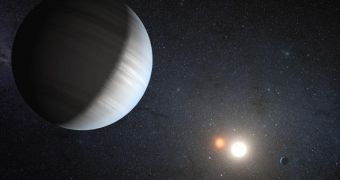Astronomers operating the NASA Kepler Telescope announce the discovery of two extrasolar planets in a binary star system Kepler-47. The space observatory identified more than 2,300 exoplanetary candidates to date, and it is designed specifically to search for new worlds via the transiting method.
Located in the constellation Cygnus, around 4,900 light-years away, the star system is weird because it contains two stars orbiting each other, which are in turn orbited by two planets. Until not long ago, it was thought impossible for binary star systems to feature long-lived planets in their orbits.
According to the Kepler team, the discovery comes less than a year after the telescope identified the first-ever circumbinary planet, orbiting two suns. The most important implication of the new study is that planetary systems, at least in our galaxy, are extremely diverse in nature.
Data provided by the observatory suggest that one of the stars in Kepler-47 is about the size of the Sun, but only 84 percent as bright. Its companion has only 1 percent solar luminosity, and weighs only a third of a solar mass. The objects eclipse each other once every 7.5 days.
An interesting result of the new study is that the innermost planet in the system, called Kepler-47b, orbits both stars in just 50 days. By comparison, Mercury – the closest planet to the Sun – takes about 88 days to complete a full orbit.
Though classified as the smallest known transiting circumbinary planet, this alien world has at least three times the radius of Earth. Planetary scientists believe that its atmosphere is heated to extreme temperatures by its proximity to the two stars.
The second planet is Kepler-47c, which takes around 303 days to orbit the star system. This means that – translated into our own solar system – it would lie between the orbits of Venus and Earth, closest to us than to our neighboring world.
Though it could very well lie in the system's habitable zone (the area where liquid water may exist), it's highly unlikely that Kepler-47c can support life. Early results suggest it is a Neptune-mass gas giant.
“In contrast to a single planet orbiting a single star, the planet in a circumbinary system must transit a 'moving target.' As a consequence, time intervals between the transits and their durations can vary substantially, sometimes short, other times long,” Jerome Orosz says.
“The intervals were the telltale sign these planets are in circumbinary orbits,” adds the expert, the lead author of the new study, and an associate professor of astronomy at the San Diego State University. Details of the work appear in the latest issue of the top journal Science.
“Unlike our Sun, many stars are part of multiple-star systems where two or more stars orbit one another. The question always has been – do they have planets and planetary systems? This Kepler discovery proves that they do,” comments Kepler mission principal investigator, William Borucki.
“In our search for habitable planets, we have found more opportunities for life to exist,” concludes the expert, who is based at the NASA Ames Research Center, in Moffett Field, California.

 14 DAY TRIAL //
14 DAY TRIAL //